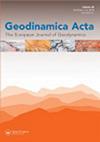土耳其西北部Kalkım-Gönen盆地晚渐新世-早中新世古生态学研究
IF 1.5
Q1 Earth and Planetary Sciences
引用次数: 9
摘要
Kalkım-Gönen盆地上渐新统-下中新统Soma组的辐射和孢粉资料给出了有关年龄和孢粉含量的新结果。本文对dani本文章由计算机程序翻译,如有差异,请以英文原文为准。
Late Oligocene–Early Miocene palaeoecology based on pollen data from the Kalkım-Gönen Basin (Northwest Turkey)
Radiometric and palynological data of the Upper Oligocene–Lower Miocene Soma Formation from the Kalkım-Gönen Basin yield new results related to age and palynological contents. In this study, Upper Oligocene strata from the Danişment and Linfa areas and Lower Miocene strata from the Bengiler area were sampled palynologically and for radiometric dating. The Danişment assemblage, which is older than the Linfa assemblages, mainly contains coniferous and evergreen to deciduous mixed mesophytic forest elements. Relatively high quantities of the altitudinal plants Picea and Abies, indicate a cooler palaeoclimate. The Linfa associations mainly include coniferous and riparian elements. Pollen of the riparian plant Alnus and Taxodiaceae indicative for the swamp forest community was predominant, probably as a result of a high lake level. There is a hiatus during the Oligocene–Miocene transition, probably showing a non-depositional phase and sea-level fall indicating the Mi-1 glaciation event. Higher in the sequence, the Aquitanian Bengiler sediments include high amounts of coniferous forest elements as well as components indicative for the evergreen and deciduous mesophytic forest and also riparian forest and swamp forest. Due to presence of thermophilous taxa Reveesia, Mastixiaceae and Arecaceae, a warm and humid palaeoclimate is inferred according to quantitative analyses using the Coexistence Approach.
求助全文
通过发布文献求助,成功后即可免费获取论文全文。
去求助
来源期刊

Geodinamica Acta
地学-地球科学综合
CiteScore
4.50
自引率
0.00%
发文量
0
审稿时长
25 weeks
期刊介绍:
Geodinamica Acta provides an international and interdisciplinary forum for the publication of results of recent research dealing with both internal and external geodynamics. Its aims to promote discussion between the various disciplines that work on the dynamics of the lithosphere and hydrosphere. There are no constraints over themes, provided the main thrust of the paper relates to Earth''s internal and external geodynamics. The Journal encourages the submission of papers in all fields of earth sciences, such as biostratigraphy, geochemistry, geochronology and thermochronology, geohazards and their societal impacts, geomorphology, geophysics, glaciology, igneous and metamorphic petrology, magmatism, marine geology, metamorphism, mineral-deposits and energy resources, mineralogy, orogeny, palaeoclimatology, palaeoecology, paleoceanograpgy, palaeontology, petroleum geology, sedimentology, seismology and earthquakes, stratigraphy, structural geology, surface processes, tectonics (neoteoctonic, plate tectonics, seismo-tectonics, Active tectonics) and volcanism.
Geodinamica Acta publishes high quality, peer-reviewed original and timely scientific papers, comprehensive review articles on hot topics of current interest, rapid communications relating to a significant advance in the earth sciences with broad interest, and discussions of papers that have already appeared in recent issues of the journal. Book reviews are also included. Submitted papers must have international appeal and regional implications; they should present work that would be of interest to many different specialists. Geographic coverage is global and work on any part of the world is considered. The Journal also publishes thematic sets of papers on topical aspects of earth sciences or special issues of selected papers from conferences.
 求助内容:
求助内容: 应助结果提醒方式:
应助结果提醒方式:


